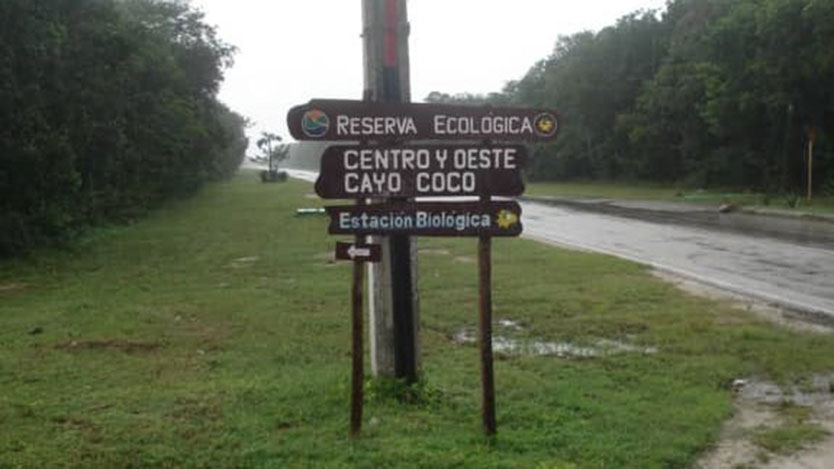Although it is recognized for the beauty of its beaches and hotel facilities, the tourist destination Jardines del Rey, located in the keys to the north of the province of Ciego de Ávila, is also one of the most prominent reservoirs of flora and fauna in Cuba, grouping large islets with capacity for abundant plant formations and the feeding of numerous animals.

The Central and Western Ecological Reserve of Cayo Coco is located in this demarcation, a protected area of national significance and one of the largest in the nation, with 36,040 hectares —according to agreement 6803/2010 of the Executive Committee of the Council of Ministers—, where Biodiversity conservation is the main corporate purpose.
Daylon Fundora Caballero, head of the Department of Natural Resources, Prioritized Ecosystems and Climate Change, of the Environment Subdelegation of the territory, specified that land mollusks, birds and reptiles determine the relevance of this prioritized ecosystem.
They distinguish as the most significant species the bat and jutía conga, the green woodpecker (strict subspecies of this archipelago) and the cotunto siju, in addition to have the second largest population of flamingos and one of the three cabrerito de la ciénaga identified in the National Geography.
The presence of Metachroma and Longitarsus sp beetles stands out; the first one, registered only in Coco and Guillermo keys; while the habitat of the other is limited to the area of the Ecological Reserve.
In the vegetation close to the coast, molluscs corresponding to the genus Cerion coexist, with various endemic forms; and, in this ecosystem, the second highest sand dunes in Latin America can also be seen, with heights that vary between 10 and 15 meters.
Characterized by the blue and yellow tones of its skin, the Anolis equestris cyanneus lizard lives there, a restricted endemic species and in critical condition —it is only found in specific places in the area—; and in that environment, other species typical of Cuba also develop, such as the majá de Santa María and the iguana, Fundora Caballero argued.
The area categorized as an Ecological Reserve —he pointed out— is the main stopover point for the North Atlantic migratory corridor in the entire Sabana-Camagüey Archipelago, due to the fact that the largest plant formations of the keys located in the north of Cuba are located in that space, which allows birds to protect and feed.
Particular mention —he considered— deserve the small cave systems and the La Jenifer cenote, sites of geological importance.
The aforementioned authority in matters of natural resources assessed the state of conservation of this area of national significance as favorable, as a result of the actions carried out by workers of the Provincial Flora and Fauna Company (EPFF), in charge of the administration.
Other organizations such as the Ministry of Tourism (Mintur), which has hotel and non-hotel facilities in the vicinity of the protected area, are also projected as defenders of natural values, in addition to two, La Cueva del Jabalí and Sitio La Güira —administered by the Branch Extrahoteleros Palmares and the Islazul Hotel Chain, respectively, — located within the reservoir and where care for nature is promoted.
The Mintur recognizes the obligation, necessity and importance of preserving this environment, due to the interdependence relationship established between the so-called leisure industry and nature to satisfy the leisure needs of national and foreign clients.
In accordance with international trends, Jardines del Rey —contemplating the area of the ecological reserve— is also committed to displacing traditional tourism and giving space to alternative tourism, which promotes respect for the environment, seeks few changes to the landscape and accentuates interest in the best preserved spaces.
Such circumstances stimulate the preservation of nature and turn it into a tourism product that provides funds for sustainable development and conservation activities in protected areas.
Destinations such as Cayo Coco have the facility to combine the sun and beach and ecological modalities, both with great acceptance and, the latter, identified among the preferences of international travelers, including groups of bird watchers —from Canada, the United States and the United Kingdom. Kingdom—that establish themselves every year in the northern keys of Ciego de Avila to contemplate them.
Faced with the risks posed by unavoidable anthropogenic factors, fundamentally the development of hotel and non-hotel infrastructure and tourism insurance; and others of natural origin such as climate change, the organisms represented in that place increase their efforts to protect the prioritized ecosystem.
The advisory and control tasks, in charge of the EPFF, the Territorial Delegation of the Ministry of Science, Technology and Environment, the Office of Regulation and Environmental Safety, and the research centers for Coastal Ecosystems and Environmental Engineering and Biodiversity, constitute other guarantees to preserve a true natural treasure.




